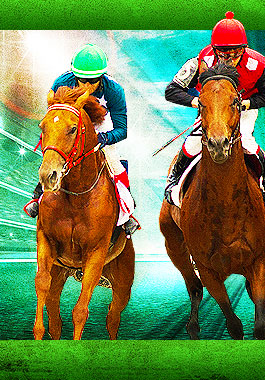Betting Tips
Here are simple angles that you should watch out for. Carefullly consider these angles, utilize them today where they make sense, and have fun developing your own set of angles that work for you.
Fresh Off the Stable
Some horses run well after an extended period of rest, and some trainers excel with this move, too, getting a horse ready to run one big effort after resting for an extended period of time. If a horse is running off of an extended rest (also known as a 'layoff'), this angle should be considered.
Two ways to look for this angle:
Take a look back at a horse's previous efforts running off of a layoff. Did he win or run better than he did in races when he had less rest? If so, then consider betting on him today.
Take a look at the trainer angle section. Does this trainer excel with horses running off of layoffs? If that's the case, you may want to play this horse today.
TLC (Tender Loving Care)
It's only logical that horses will show improvement on the race track when moved to a new trainer who conditions his horses in different and sometimes more effective ways than the trainer who previously conditioned the horse or greyhound.
There are two good ways to clue you in to this angle: In claiming races, compare the winning percentage of the current trainer to the previous one. When a horse is claimed, past performances will show you the winning percentages for the year for the last trainer and the new one.
If the new trainer is having a considerably better year than the previous one (let's say the new trainer has 16 percent wins and the old one only had 5 percent wins), then you can upgrade the horse's chances with the new trainer. The trainer stats at the bottom of each past performance give you crucial data about whether a new trainer succeeds with horses moving into his or her barn.
Place a bet on your favorite horse now.
The Horse for the Course
Some horses just love certain racetracks and aren't nearly as successful elsewhere. A great example is Lemon Drop Kid, who won the Futurity at Belmont as a 2-year-old but never threatened in subsequent stakes races in Kentucky. When he returned home to Belmont he ran a huge race and won the Belmont Stakes at 29-1! Lemon Drop Kid was a horse for the course. He loved Belmont Park. If you see a horse that shows a particularly strong record at today's track, take note because he may be a horse for the course.
The Surface Switch
Some horses excel going from turf to dirt, or vice versa. Why? Turf is sometimes a less jarring surface than dirt. Therefore, if a horse has been racing on turf while his competition has been slaving away on dirt, the turf horse that is back on the dirt might have an advantage. And some horses excel going from dirt to turf because they prefer the more forgiving nature of the grass.
Just What the Doctor Ordered
Treatment with Lasix sometimes leads to a dramatically improved performance from a horse. The medication is prescribed when a horse has bled. Bleeding is a result of the rupturing of tiny blood vessels in the lungs, which is usually caused from overexertion in a horse's previous race.
Below are some hints you can use when it comes to Lasix:
If you're looking for the big improvement with a horse running on Lasix for the first time, it's best if you see a solid workout since his last race. This indicates the horse may be training well on Lasix and should be ready to 'pop' first time out on this medication.
Sometimes horses will show big improvement on Lasix when running on the medication for the second time. If the horse didn't show big improvement first time on the medication, second time Lasix can be an interesting angle, too! Always look at the DRF Trainer Stats at the bottom of each past performance to see if a trainer has a positive history with horses running First-Time Lasix.
If they've won 15 to 20 percent or more with their horses adding Lasix for the first time, this is a very positive sign that the horse's performance should improve with the addition of Lasix.
Horses adding Lasix for the first time who are 2- 3- or 4-yearsolds, or are that age and coming over from Europe for the first time, are more likely to 'pop' first time on Lasix than older horses.
The Distance Specialist
Some horses just love certain distances. Others have the ability to handle tricky distances that many horses struggle with. For example, when you see a horse running a marathon distance of 1 1/2 miles, you should understand that 1 1/2 miles is a distance that many horses just can't handle. Fortunately, race cards provide this crucial distance data in the career box. This data helps you find horses that have previously excelled at tricky distances such as 1 1/2 miles.
If you see a horse that shows a particularly strong record at the distance on that surface, take note - he may be a distance specialist.
Place a bet on your favorite horse now.



